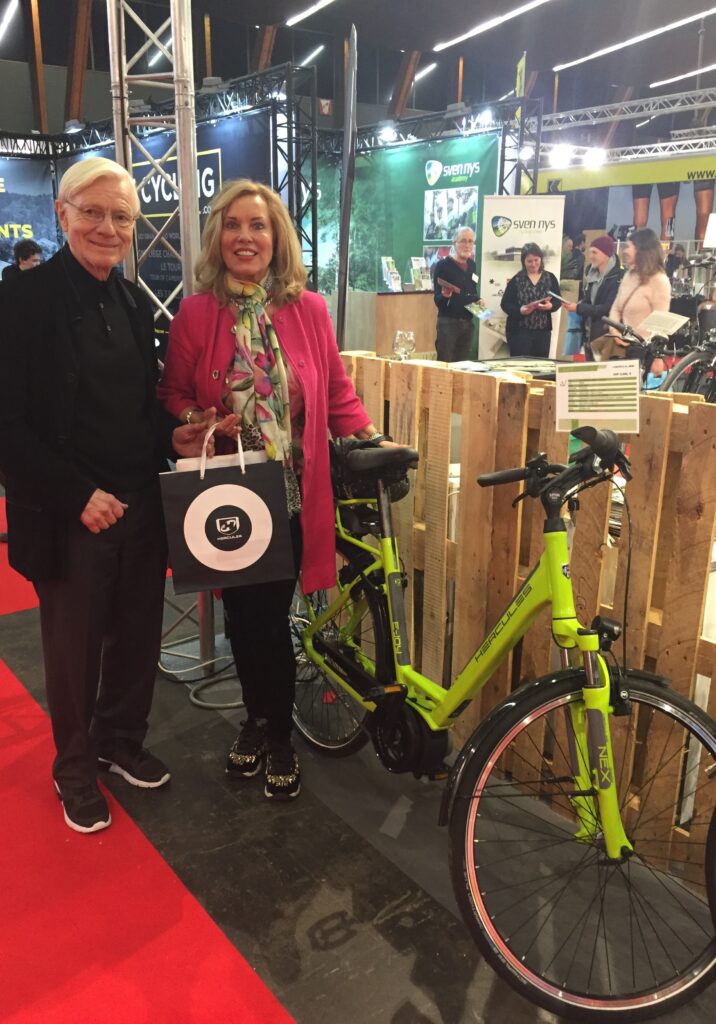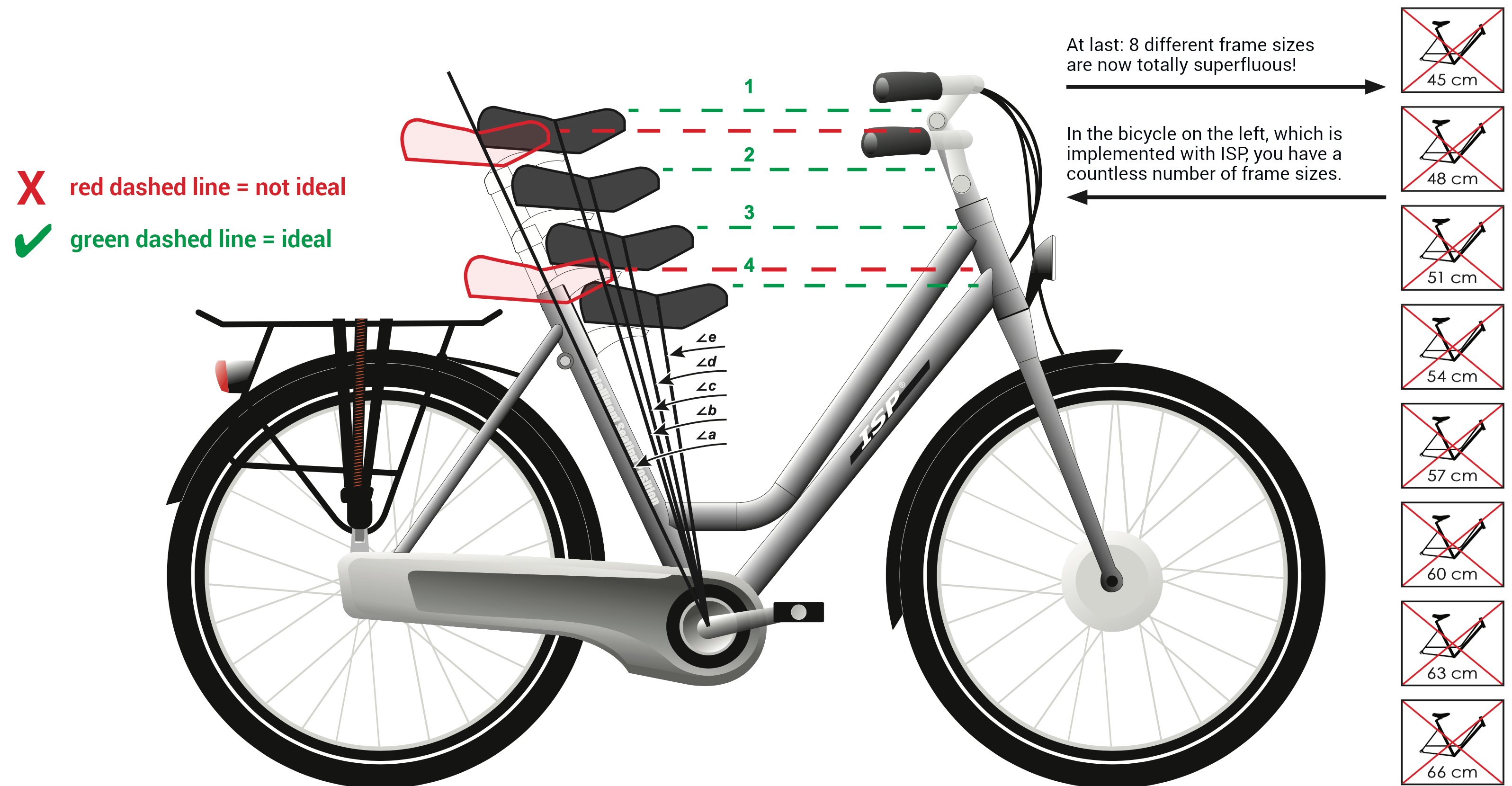Technology
THANKS TO ISP, ONE BASIC BIKE IS ALL YOU NEED TO MAKE DIFFERENT FRAME SIZES REDUNDANT
Bicycle safety is an increasingly important topic for which there is plenty of international attention. With the Intelligent Seating Position (ISP), cycling guru Andries Gaastra is putting his best foot forward and making cycling a lot safer. Not only that, but he is also simplifying logistics and making the industry more sustainable. More and more bicycle manufacturers are building ISP into their bicycles.
Gaastra is the driving force behind the patented ISP. With this system, he makes it possible for one frame to provide all types of cyclists - tall and short - with a suitable e-bike. He can guarantee this thanks to a frame geometry that adapts to the body, based on a multi-variable seat angle. For shorter cyclists, the saddle height is lowered and at the same time the top tube length is reduced. And with taller cyclists, exactly the opposite happens. “You sit lower if necessary and then also automatically come closer to the handlebars. This is incredibly important for greater confidence and safety. Almost all manufacturers assume a so-called standard frame size range of 45
to 66 centimeters. In between there are jumps of 3 or sometimes even 6 centimeters. They only adjust the seat tube height and often do not adjust the top tube length. As a small woman of 1.50 m, you may be sitting lower, but you can't quite reach the handlebars. That is an undesirable situation."
No need to dismount
Gaastra's multivariable seat angle also ensures that cyclists can keep both feet on the ground at all times. They don't have to dismount and can remain seated in the saddle. For example, the dangerous mounting and dismounting procedures at traffic lights, where in practice many accidents occur, do not occur in this way,
says Gaastra. We ensure that the bike retains its adult appearance; it does not look like a children's bike.
The ingenious solution also means positive news for aspects such as logistics and sustainability. While as a specialist dealer, you have to buy all possible frame sizes for average bikes without this technology, on the contrary, the basic model is all you need for bikes with ISP. It's a win-win situation: delivery is faster, the bike is always available, the turnover rate increases, and you need less storage space. Thanks to these improved logistics, bicycles with ISP are also more sustainable. That's a hot issue at the moment.
Also ideal for shared bicycles
More and more internationally renowned manufacturers are building ISP technology into their bikes. One of these is Gazelle, which supplies a Gaastra-designed bicycle
called the Balance. Almost immediately after its introduction, this special bicycle was awarded the title of safest bicycle in Europe
. This is all thanks to ISP. Gaastra is now in contact with other manufacturers about supplying the technology. In the field of rental, leasing, and shared bicycles we see a lot of opportunities and possibilities. The
1 bike fits all
concept appeals to parties with shared bikes, because they have to deal with a variety of users.
The first version of the technology was introduced at the beginning of this millennium. In the intervening years, the ISP concept has been further developed. Gaastra is currently busy behind the scenes to make the technology suitable for cargo and transport bikes as well. This is an absolute growth market in the bicycle industry. There, too, you have to deal with changing users of a bike. ISP can be a great solution for companies with transport bikes. When it comes to transporting children, it brings maximum safety
says the former manufacturer of Batavus, Koga-Miyata, and Giant, and founder of Shimano Benelux.
[Source: R. Booltink, Tweewieler sept. 2020]
How does ISP work?
In the picture above, you can see that the saddle is mounted in front of the post and can be easily adjusted up or down at the front of the seat tube. This is in contrast to a conventional bike, where the saddle is adjusted from the center of the seat tube.
The combination of the fixed seat tube angle, angle a, with the multi-variable seat angles b, c, d and e (see the black lines), of the bicycle with ISP, is the basis for the aforementioned Automatic-Geometry-Positioning
(AGP).
Why? With each adjustment of the saddle up or down, the correct distance from the saddle to the head tube is found simultaneously and fully automatically. (Refer to the green dotted lines 1, 2, 3 and 4).
Only one frame, eight positions, and safety first!
Frame sizes ranging from 45 to 66 cm are now gathered into one bike with the “1 bike fits all”... more bike with less material. Sustainable! And it always fits!
This unique seating concept allows the saddle to be positioned in such a way that there is always a good relationship between the saddle, the handlebars, and the pedals. This means that the rider can put both feet on the ground and stay on the saddle, even during an emergency stop - safety first, thanks to the Automatic-Geometry-Positioning.
“THE NEW NORMAL IN THE BICYCLE INDUSTRY!”
The advantages of bikes with ISP compared to conventional bikes:
| BIKES WITH ISP: | CONVENTIONAL BIKES: | |
|---|---|---|
| FIT: | Can always be quickly adapted to any rider from about 1.50 m to 2.00 m. The adjustment range of a bike with ISP is 2 to 2.5 times greater than that of a conventional bike. 1 bike fits all |
Difficult to make it fit quickly; therefore, constantly searching for the right size to find a well-fitting bike. Time-consuming and complicated. |
| DAILY USE: | The whole family can fit on it! Also ideal for rental, leasing, sharing, loaning, and service bikes. | Multiple bikes are needed to get the same benefits. The adjustment range is very limited. |
| SAFETY: | Maximum stability. Both feet are always directly on the ground. Falling over with your bicycle is now virtually impossible! | Similar stability is hard to find here. Insecure feeling when getting on and off the bike when the bike is still rolling. This problem results in approximately 15% of all bicycle accidents. |
| COMFORT: | Pure comfort - riders sit "nice and easy" in the saddle, with both feet on the ground at every stop. | At every stop and again and again, on the saddle, off the saddle...Tiring, isn't it? |
| BALANCE: | The center of gravity is more towards the bottom bracket, something which results in a more balanced riding feeling. | In most cases, a large part of the weight is over the rear wheel and not enough over the front wheel, which can negatively affect handling, especially in curves and wet weather. |
| ENVIRONMENT: | There is only one mainframehere: results in less production, freight, storage, and packaging effort in all links of the supply chain. |
Thanks to all those different frame sizes, there is a so-called forest of models. The result is a greater demand on machines and tools. In addition, more raw materials are required, resulting in additional efforts in terms of transport, storage, and packaging. |
| RESIDUAL VALUE: | The ISP bike - with regular maintenance - remains current at all times for every rider and function. Can have a positive effect on a sale or trade-in. | More limited prospects in terms of residual value due to a very limited fitting range and therefore no multi-functional use. |
| LOGISTICS: | Based on just one multi-functional mainframe, the number of models available in the factory and in your bike store can be significantly reduced. In practice, this means that the ISP bicycle you choose is not only available faster, but also fits optimally every time. |
The excessively large number of frame sizes (end-of-line models) results in delivery delays at all stages of the supply chain. In the worst case scenario, the bike you have chosen in the desired frame size is already sold out. Often people will then settle for a bike that is too low or too high, which will almost always lead to very unpleasant consequences. |




